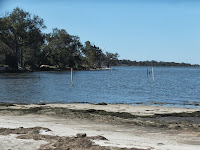FRIDAY 15.11.2013: The main reason for visiting this area was The Pinnacles. The Pinnacles are limestone formations contained within Nambung National Park, near the town of Cervantes.
 |
| BEST WE COULD DO IS AN INTERNET PHOTO! |
The raw material for the limestone of the Pinnacles came from seashells in an earlier epoch rich in marine life. These shells were broken down into lime rich sands which were blown inland to form high mobile dunes. The mechanisms through which the Pinnacles were formed from this raw material are the subject of some controversy, with three mechanisms having been proposed. As The Pinnacles are in the National Park we had hoped to do the 'drive through'. Tried to organise doggy care - no, no to leaving the dogs in the car park - essentially no! Little disappointed we missed this, but we knew National Parks would be the trade off for bringing the puddles on the road trip! Instead we drove through the National Park on Indian Ocean Drive to reach our next destination - go figure! Did enjoy the wildflowers.
The great find of the day were the endless fields of grass trees all the way down the Indian Ocean Drive.
Stayed the evening at Moore River Bridge Rest Area. We have finally found the ultimate fashion accessory. As we have moved further inland the flies have become above and beyond unbearable. Saw fellow travellers in the hat nets and we have finally succumbed - they are s-o attractive, but effective!
 |
| WE WILL BE ADDING STRAW HOLES! |
Leyland Madison has also conceded and is more than happy to don the net - yes, Sybil has to purchase another net for her use!



















































